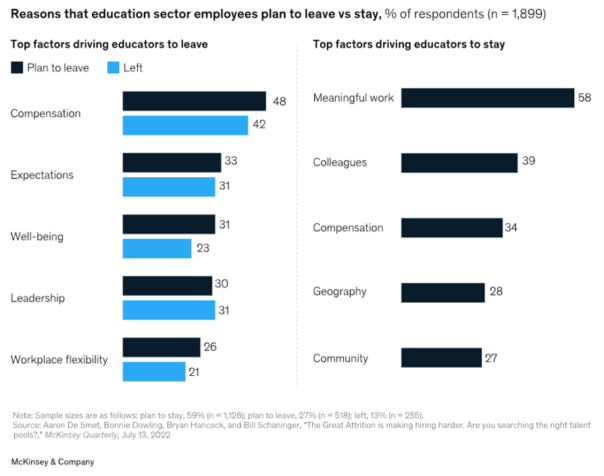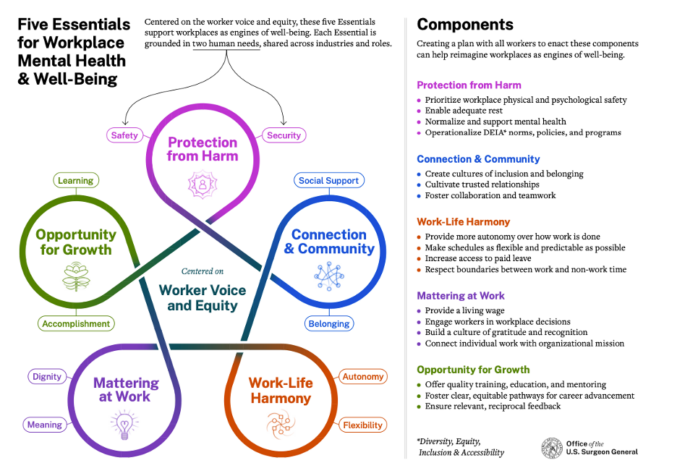Teacher Well-Being: Beyond Yoga and Pizza Parties

It’s in the news and on your campus. Professional education associations are sounding the alarm. More teachers are leaving the profession, and the pipeline of new educators is shrinking. As schools of all kinds—public, private, K–12, and higher ed—struggle to recruit faculty, they must also work harder to retain them.
Many cite burnout as the primary reason they are leaving the teaching profession, and in response, schools are trying to pivot and focus on the well-being of their faculty and students. Some provide mindfulness training, group activities, and employee assistance programs. But yoga and pizza parties cannot make up for the long hours, tense interactions, and vicarious trauma our teachers encounter every day. So, what can school leaders do to address teacher well-being? To begin, let’s listen to what teachers say is causing their burnout. Only then can we address the issue.
The State of Teacher Well-Being
The 2023 State of the American Teacher Survey found that teachers are more stressed at work, experience worse well-being, and are more likely to experience burnout than other working adults. Only slightly more than half reported adequate access to well-being and mental health support.
Also in 2023, McKinsey & Company published research indicating that nearly one-third of K–12 professionals surveyed in the U.S. were considering leaving their jobs. The respondents in their survey pointed to inadequate compensation, unmanageable workloads, and inability to protect their well-being as motivation.

This phenomenon is not unique to public school educators. Private schools and higher education institutions are feeling the impact, as indicated by the National Association of Independent Schools’ 2023 Hot Issues Survey and this report by Science Direct on higher education, which determined that the key factors associated with intent-to-quit were low perceived organizational support and high rates of exhaustion, depression, and anxiety.
Creating a Culture of Well-Being in Education
Recently, our team at Blackbaud partnered with digital wellness and leadership coach Meico Marquette Whitlock to create this toolkit that outlines how to cultivate a culture of well-being in an organization. While it was created using grantmaking language, you could easily replace “grant makers” with “educators” and “grantees” with “students” to find highly relevant resources and insights for educators.
To begin, he highlights the five essentials for workplace mental health and well-being—as identified by the U.S. Office of the Surgeon General—including protection from harm, connection & community, work-life harmony, mattering at work, and opportunity for growth.

These five essential components are key to any organization, and they are all intertwined. How can you apply this to educational institutions?
Protection from Harm
It is a leader’s responsibility to prioritize the physical and mental health of those in your school community. When faculty intention-to-quit studies like those above highlight burnout, anxiety, and depression as causal factors, it’s time to take action. But how do you set up a system of protection for these vital people?
- Create healthy boundaries: In this digital age, everyone is just a text away. But that constant availability can have a negative impact on mental health. Students—and in the case of K–12 schools, their families—do not need 24/7 access to teachers. Set expectations with students and families during orientation and empower educators by consolidating communications through the student’s online portal.
- Leverage technology: Speaking of that online portal, have you explored all the capabilities in your student information and learning management systems (SIS and LMS)? Ensure they have robust messaging, dynamic grading tools and rubrics, and innovative tools to help build assignments, quizzes, and more. Utilize everything possible in your software to alleviate faculty workload.
- Remove non-critical responsibilities: People who are passionate about their mission are more likely to accept additional duties, but adding administrative work to an educator’s already full schedule can accelerate burnout. What are they doing now that could be postponed, reassigned, or eliminated? Do you have volunteers, students, or even donors in your community to take on some of that work? Let your teachers focus on the important human work with their colleagues and students.
Connection & Community
In the McKinsey report shared above, the second most compelling factor driving educators to stay was their colleagues. When people feel connected to one another and to their organization’s mission, they are less likely to seek employment elsewhere. That culture of belonging is critical in education for students, faculty, and staff.
While the human, mission-based work of education may drive retention, a culture of belonging doesn’t happen automatically. Leaders play a critical role in fostering trust and collaboration with and among faculty and staff.
- Normalize DEIA: Diversity, Equity, Inclusion, and Accessibility programs and policies are critical to a culture of belonging. Make DEIA practices so essential to your organization that they become second nature to everyone.
- Build meaningful relationships: Listen to your people. Let them know they can come to you with suggestions, challenges, and complaints.
- Nurture cross-functional and inter-departmental collaboration: Teamwork makes the dream work, and when student success is the dream, the more people who are aligned on purpose and practice, the better.
Work-Life Harmony
This may be the most challenging for educators. Too often, teachers are grading on weekends and staying late to meet with parents or students. Then there are all the sporting and social events, productions, and other activities that many people enjoy, but too much off-hour participation can accelerate burnout.
- Be as flexible as possible: Are your faculty schedules consistent enough to allow for flexible arrangements? Do teacher workdays in K–12 have to be at the school, or can they accomplish as much or more working at home that day? Do adjunct professors at your institution have the flexibility to teach remotely on days when their personal life would dictate it? What meetings can you eliminate?
- Respect non-work time: Like boundaries between students, families, and teachers, leaders must set boundaries when building relationships, so everyone feels empowered to maintain their own respectfully. Don’t reach out to team members after hours unless it is an emergency and establish guardrails to ensure manageable daily/weekly/monthly duties for everyone.
- Normalize time off: This may be difficult due to the seasonality of education, but time off is critical to well-being. Increase access to paid leave by building your pool of substitute and temporary help. Are there retired educators in your community? Parents or volunteers who can fill in temporarily? Private K–12 schools often have more flexibility with staffing.
Mattering at Work
Perhaps the best news in the McKinsey report is that nearly two-thirds of those planning to leave their current positions intend to stay in education. These are passionate, dedicated people who care deeply about students. So, why do they feel the grass is greener in another role? How do you ensure they know that they and their work matter at your institution?
- Increase salaries: Yes, this is easier said than done. But people want to feel valued and successful organizations are finding a way. First, prioritize your people when determining how undesignated donations are spent. If you haven’t already, adjust your donation forms so the first option on your designation list is something like “Area of Greatest Need,” which all too often is faculty retention. Does your area have a high cost of living? Some institutions are offering housing to new teachers. Think strategically.
- Recognize hard work: Show gratitude for the difficult everyday work that is education. It’s too easy to take it for granted when everyone is putting in extraordinary effort. But a little recognition can go a long way.
- Engage faculty in important decisions: Don’t operate in a vacuum. When making operational changes, establishing new policies, or selecting new technology that will impact faculty, get their input. Establish committees with spokespeople for each stakeholder group and listen to their feedback.
Opportunities for Growth
Not everyone wants to be the boss, but nobody wants to feel stagnant. Opportunities for growth could mean professional development, ongoing training, and mentorship programs.
- Schedule performance reviews: Again, prioritize your people. Don’t let the busyness of your own role prevent you from conducting regular evaluations for your team members. Through those conversations, you can determine what they want for their futures and decide how you can help them get there.
- Appoint mentors: One way to recognize a high-performing faculty member is to ask them to mentor a less experienced or struggling peer. The role of mentor does not necessitate a salary increase, but you should acknowledge the additional time it will take and remove unnecessary administrative tasks where possible.
- Create pathways for advancement: Establish milestones and expectations for those who are interested in career growth. You may not have a department chair position right now, but who is next in line when the current one leaves or retires?
More Resources
By actively addressing the key areas of well-being mentioned above, organizations can create a thriving work environment where employees experience reduced burnout, increased engagement, and higher productivity. As a result, turnover decreases, and employees are more likely to be physically, mentally, and emotionally healthy.
Here are some more resources:
- Faculty Recruitment Reimagined: A Fresh Perspective for Private Schools by Kerry Martin, a 25-year private school veteran
- Wellbeing Inspires Welldoing, How Changemakers’ Inner Wellbeing Influences Their Work from the Wellbeing Project
- Education Week’s Teacher Pipeline series
- How Grantmakers Can Jumpstart a Culture of Well-Being (just change “grant makers” to “educators” and “grantees” to “students”)
- Understanding and Fostering Mental Health and Well-Being among University Faculty: A Narrative Review from the Journal of Clinical Medicine
